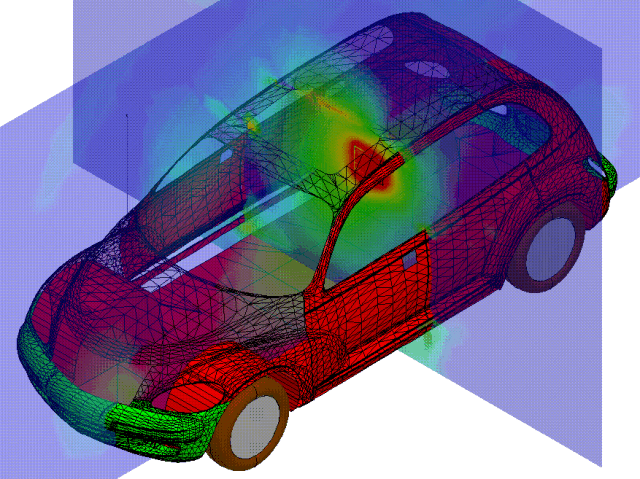Electromagnetic compatibility simulation, EMC simulation analysis test
Business Contents:
Electromagnetic Compatibility Simulation, Magnetic Field Simulation Analysis, High-frequency / Low-frequency Electromagnetic Simulation for industries such as electronics, automobiles, and medical care.
Value of Electromagnetic Compatibility Simulation:
1. Through simulation analysis, characteristics such as crosstalk between cables and radiation interference of cables can be obtained, and interference current and voltage at any position can be obtained. Based on this, the cable layout scheme within the system can be optimized.
a. Identify the main interference sources;
b. Analyze the interference propagation characteristics, paths, and frequency bands;
c. Find corresponding measures to suppress interference.
What is Electromagnetic Compatibility EMC Simulation? What is EMC Simulation?
Electromagnetic compatibility refers to a "compatible state" in which electronic and electrical equipment can work normally without interfering with each other when they are in the same environment. The National Standard Electrotechnical Commission's understanding of "electromagnetic compatibility" is that vehicles or components can operate stably and reliably within a specific electromagnetic environment, and at the same time, will not cause unacceptable interference to other equipment in this electromagnetic environment.
Electromagnetic compatibility can be measured by test equipment, but the cost is relatively high. Using finite element analysis software to conduct electromagnetic compatibility simulation to obtain a series of simulation results and optimize the design scheme is called EMC simulation.
General Requirements for Electromagnetic Compatibility Simulation:
1. The electromagnetic interference (Electromagnetic Interference, EMI) generated by the equipment or system to the environment during normal operation shall not exceed a certain limit;
2. It means that the equipment or system has a certain degree of immunity (Electromagnetic Susceptibility, EMS), that is, electromagnetic sensitivity, also known as electromagnetic immunity, to the electromagnetic interference existing in the environment.

Application Case - Vehicle Electromagnetic Compatibility Simulation
Electromagnetic compatibility (EMC simulation) is an important scientific category of finite element analysis and an essential part of the development of any electronic equipment. According to the law, products must comply with relevant (EMC simulation) electromagnetic compatibility standards when sold on the market. These standards regulate electromagnetic radiation and the sensitivity of electrical and electronic systems. Successful products must strike a balance between electromagnetic compatibility and product competitiveness design requirements (such as size, cost, and performance), which poses a huge challenge to engineers. The earlier potential EMC problems are discovered, the less impact they will have on the design process. By incorporating EMC-compatible design in the early stage, further costly development iterations can be avoided later. Potential EMC problems can be identified and solved at the very beginning of the design process, before building the first prototype. It includes the PCB rule checking module and 3D full-wave simulation of PCBs and cable harnesses. Based on the System Assembly Modeling (SAM) technology, complete system-level EMC simulation of chip packaging, PCBs, wire harnesses, chassis cabinets, and three-dimensional structural platforms can be completed.
Main Research Directions of EMC Simulation in Automobile Development:
1. Electromagnetic interference of automobile components to other components in the vehicle, human body, mobile phones, etc.
2. Electromagnetic immunity of automobiles to electromagnetic interference from various components and radar, antennas, charging equipment, etc. in the external environment.
Fields Involved in Electromagnetic Compatibility Simulation and EMC Simulation:
1. EMC testing for ICT equipment
2. Preliminary EMC testing for medical devices
3. Testing according to the national military standard GJB151B-2013
4. EMC testing for automotive electronics
5. EMC testing for rail transit
6. EMC testing for industrial, scientific and medical measurement equipment
EMC simulation includes two major items: EMI (Interference) and EMS (Sensitivity, Immunity).
Types covered by EMI test items:
Space Radiation (Radiation)
Conducted Interference (Conduction)
Click (Click) EN55014-1
Power Clamp
Magnetic Emission (Magnetic Emission)
Low Frequency Immunity (Low Frequency Immunity)
Types covered by EMS simulation test items:
Electrostatic Discharge (ESD)
Radiated Immunity (R/S)
Electrical Fast Transient / Burst Immunity (EFT/B)
Surge Immunity (SURGE)
Conducted Disturbance Immunity (C/S)
Power Frequency Magnetic Field Immunity (M/S)
Voltage Dips (DIPS)
Harmonic Current (Harmonic)
Voltage Flicker (Flicker)

Leto Intelligent Manufacturing Technology (Suzhou) Co., LTD
199 4191 2022
Business consulting/technical consulting/exchange advice
Scan code wechat consultation, 24 hours to look forward to your voice

